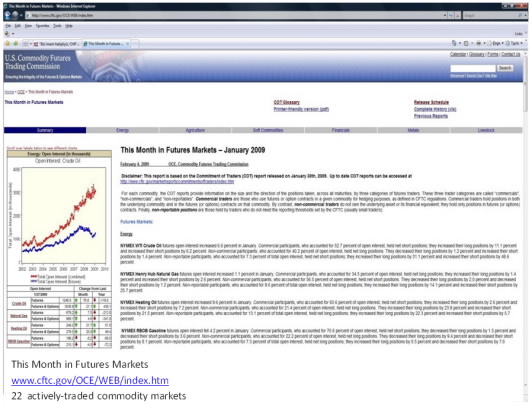Remarks of Acting Chairman Michael V. Dunn before Commodity Markets Council, Miami, Florida
February 6, 2009
Thank you, I am happy to be here to address the annual meeting of the Commodity Markets Council. Naming this annual meeting “Focus. Forecast. Forward. A Look@ the Year Ahead“ is very timely in that the year ahead will be critical given the current state of the economy and the possibility of bold reforms that will affect us all.
As you know, I am currently Acting Chairman. President Obama’s nominee, Gary Gensler, awaits consideration in the Senate. I hope he will see quick action and my tenure will be brief.
But having sat on the Commission for over four years and having been involved in commodity and credit markets for far longer than I care to recall, I’d like to share my thoughts with you on things we can do to ensure the viability and integrity of our markets.
The Commodity Markets Council brings together exchanges and market users to discuss issues facing commodity futures markets. This is critical, especially because our financial system has been severely challenged by recent economic turmoil that affects us all.
The Commodity Futures Modernization Act of 2000 ushered in some positive changes for the regulation of our industry – namely principles-based regulation. This method of regulation has proven to be very successful.
The belief of many policy makers at the time of the CFMA was that we could guard against systemic financial risks by relying on investors and institutions to monitor their own counterparty risk in over-the-counter transactions; however, this has not worked out as planned.
Recent events have shown this theory to be false, with tragic consequences and untold hardship for many Americans.
Thus far, our futures industry has sturdily weathered financial storms that have swamped others—thanks in large part to our industry’s reliance on centralized clearing and stringent mark to market and position margining requirements.
While free markets are unbelievable engines of growth and innovation, they are a tool, not an ideology.
Our real ideology should be fostering market growth, innovation and competition while ensuring that markets remain viable for price discovery and managing risk.
We must undertake a comprehensive risk assessment of the derivatives markets to identify the segments of derivative markets where systemic financial risk is a problem.
For market segments where there is systemic financial risk, we must ensure efficient, effective, and open oversight. And in providing that oversight, we must choose the regulatory tools that best fit the financial risks involved.
Two bills, one by Senator Harkin and one by Representative Peterson, Chairmen of the Senate and House Agriculture Committees, respectively, would provide the CFTC additional oversight authority over the markets. Senator Harkin’s bill eliminates many of the exclusions and exemptions for OTC trading that were contained in the CFMA. His intent appears to be to require OTC transactions to be moved on to regulated futures exchanges.
Representative Peterson’s bill seeks, among other things, to mandate clearing of OTC transactions, requires CFTC mandated position limits, establishes conditions for granting hedge exemptions, requires increased recordkeeping and reporting, and provides additional requirements on foreign boards of trade, index traders, and swap dealers.
We are monitoring these legislative developments closely and have offered to assist Congress in any way necessary to ensure that necessary and appropriate legislative issues are addressed.
While legislative proposals are being addressed, it is critical to remember that during the current crisis, the regulatory safeguards in place in the futures industry functioned as they were intended and no customer funds were lost due to a Futures Commission Merchant’s insolvency.
As you know, the CFTC ensures the integrity of the markets through market and risk surveillance of trading on regulated futures exchanges and the imposition of strict capital requirements and large trader reporting on clearing and other firms to guard against systemic financial risk.
The CFTC’s rigorous monitoring of financial risk and large trader activity makes U.S. futures markets among the most stringently regulated derivatives markets in the world—while still allowing market innovation and fostering global competition.
In the days ahead where our new administration considers what path to take in considering financial reforms, I think our story in the futures industry offers valuable insights into how we can enhance regulation while fostering financial innovation. While I am Acting Chairman, I intend to focus on 5 primary areas to achieve these goals.
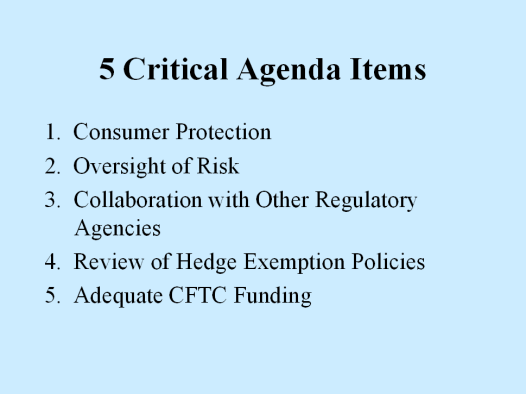
1. Consumer protection.
The primary mission of the Agency is to protect consumers and the public. To do that we need to make sure that we have adequate regulation and transparency in derivatives markets, including retail markets.
The CFTC still faces legal challenges to its ability to protect retail consumers from commodity fraud that Congress needs to address. There remains a real risk that criminals are escaping our jurisdiction through cleverly drafted futures contracts that masquerade as spot contracts. Congress should not allow this to continue. While the CFTC reauthorization bill passed last year by Congress clarified the CFTC’s jurisdiction over these contracts for forex, it did not provide a similar fix for other commodities.
In all the concern we have faced regarding the legal certainty of institutionally traded derivatives, I think we sometimes lose sight of ensuring the legal certainty of the CFTC’s ability to protect consumers. I hope we can change that this year.
In addition to legal uncertainty on the Commission’s jurisdiction, off-exchange retail forex markets continue to be significant sources of fraud. I think Congress should require these retail forex futures markets to trade on a fully regulated exchange, just as all other retail futures contracts do. It makes no sense why consumers trading forex should have any less protection than consumers trading futures in other commodities. It makes no sense why we should allow these retail off-exchange markets.
2. Oversight of Risk.
Oversight of risk in regulated derivatives markets is critical for protecting the public and ensuring the integrity of our markets. The CFTC needs to ensure it is able to identify and manage risks associated with new types of derivative markets and products.
Our current regulatory model has worked well to ensure the financial integrity of exchange traded instruments, but we need to be looking ahead for potential trouble spots and risks that may arise in the future. We need to make sure we have plans in place to address significant market events.
To do this, I am encouraging the Agency to establish a Risk Advisory Committee to assist the CFTC in identifying and addressing areas where improvement in its oversight will be critical to fulfilling the agency’s mission. This Committee would aid the Commission in reviewing and evaluating its oversight of risk and keeping abreast of changes in the markets and industry that may impact the Commission’s oversight.
3. Collaboration with other regulatory agencies.
Derivatives markets clearly cut across agency jurisdictions. Today, there are already a number of hybrid products such as security futures and futures on exchange traded funds that involve the jurisdiction of several agencies. Resolving jurisdictional boundaries has bedeviled the derivatives industry for decades.
But, even without legislation, agencies involved can do a far better job of working together to ensure customers and markets are protected while avoiding unnecessarily duplicative regulatory regimes.
The CFTC has made progress in signing Memoranda of Understanding with several other agencies governing the sharing of information, but we need to look for further opportunities to enhance cooperation and collaboration.
Whether it is trying to streamline the approval and regulation of hybrid products, or coordinate the bringing of enforcement actions, U.S. regulators can leverage their resources and expertise to promote innovation, close regulatory gaps, and make sure laws and regulations are enforced.
Instead of fighting over who regulates what, we need a renewed focus on making sure underlying financial and market risks are addressed in the most efficient way possible. We may need to establish some interagency task forces to develop new models for cooperative regulation, for instance between the CFTC and the SEC or the CFTC and the FERC.
I know that some have pushed for merger of financial agencies. However, merger, in and of itself is not a solution, it’s just an activity. The real solution is harmonizing financial regulatory approaches. Whether we merge the agencies or develop new cooperative regulatory models, the bottom line is that we need to figure out how to mesh regulatory approaches. Merger may be one avenue for accomplishing that, but it may not be the most effective or efficient.
4. Review of hedge exemption policies/Increasing market transparency.
The Commission is currently reviewing the policies under which it grants exemptions to speculative position limits.
It is my hope that the Commission will soon be seeking public comment regarding the conditions under which the Commission grants exemptions for hedging activities and what constitutes bona fide hedging activities. I encourage you to share your thoughts and ideas with us on this matter.
In order to increase transparency surrounding the markets the Commission regulates, the Commission’s Office of the Chief Economist this week began publishing a new report entitled: “This Month in Futures Markets.” The report draws from the Commission’s Commitments of Traders data and displays various market statistics for 22 actively-traded commodity markets.
It also contain a “Market Summary” page that presents graphical and tabular displays for open interest separately for futures markets alone and for the combined positions in futures markets and option-market equivalents, including changes from the previous month and year. The market summary page also provides market shares, as well as net positions of commercials, non-commercials, and non-reportable traders. This report will be put out during a six-month trial phase. I urge all of you to visit this new report and let us know what you think.
Increasing transparency is critical given that the past year has seen record price swings in commodities coinciding with a huge influx of money from new classes of investors such as index funds. Justifiably these events have inspired questions and significant concern from the public and Congress.
We have no easy answers to explain these price swings or to explain how the price of oil can fall over $100 per barrel in just a few months.
We do know some things. The data we collect and the studies we have done thus far have not shown yet that investment by speculative or index traders is directly driving prices. This data collection and analysis is a work in progress and we look forward to providing additional information and analysis when it is available. Despite this work in progress, we continue to look closely at whether current market conditions or market structures are leading to problems with price discovery or price distortions. Where we see problems, we intervene, working with the exchanges and traders to address those problems. Where we see fraud or manipulation, we bring enforcement cases.
However, there are no generally accepted models that yield answers to the question of whether speculative trading, easy credit, or “irrational exuberance” is leading to long term price distortions or a “bubble”. Unfortunately, it seems to be the case that bubbles are like recessions, you only firmly identify you are in one months after it has already begun.
In the field of toxicology, one of the mantras is, “the dose makes the poison.” Since virtually every substance has the propensity to be toxic at some dosage, a great deal of the science of toxicology is trying to find that lethal dose.
But, how does one do that in the futures markets? We all know that a healthy futures market has to have some level of speculation. Without speculation, futures markets just don’t work. How does one determine how much speculation is “just right” and how much is “toxic”?
Given the high percentage of open interest attributable to speculative trading in some of our markets we have to be vigilant for potential problems, and we are reviewing speculative positions limits.
In some of our markets, particularly agricultural markets, we have noted potential structural problems. These problems, such as lack of convergence, weak basis, and high margin requirements jeopardize the markets’ effectiveness as a risk management tool for the agricultural sector.
You are all familiar with these basis charts.
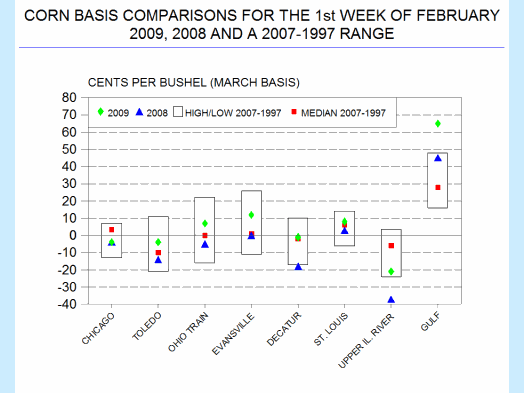
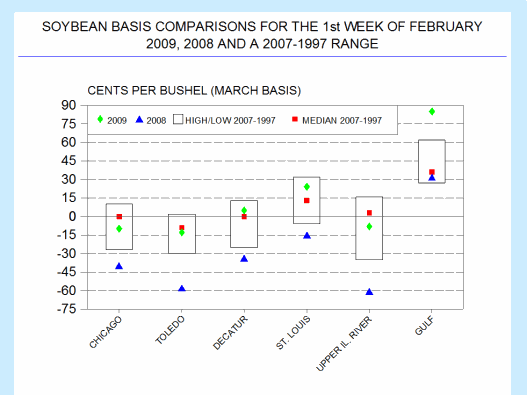
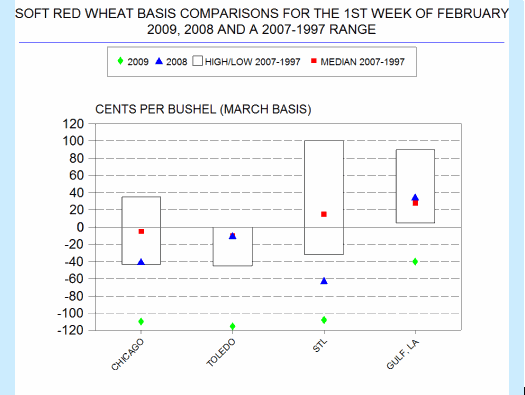
Some market participants believe that index trading is a significant cause of these problems in combination with other market factors. They believe that the nature of the physical supply of agricultural commodities means that index funds are causing an upward impact on prices either through high demand for long futures contracts or through impacts upon the cash markets
We have to take these concerns seriously. There have, of course, been periodic problems with convergence and basis in the agricultural markets over the years. But, we cannot rule out that speculative trading, including the periodic roll of index fund positions may be contributing to the problems we see today.

With regard to the contract changes already in place for the July 2009 Wheat contract, we view that as a first step toward dealing with the convergence problem.
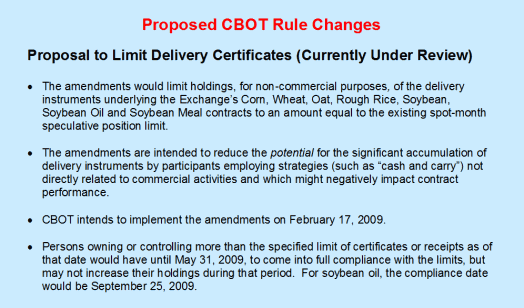
The current CBOT rule change proposal to limit holding delivery instruments is under review at the Commission. This proposal was put out for public comment, and the comment period closed earlier this week. We are analyzing the comments, and the Commission hopes to finalize its review in time for CBOT’s intended implementation date of February 17, 2009.
None of these rule changes, however, ends the discussion, and the Commission’s examination of convergence issues.
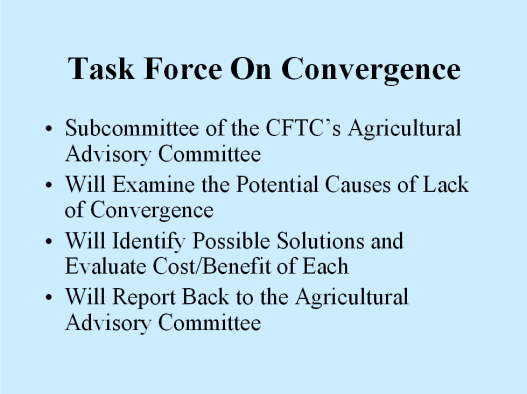
To further review the issue of convergence, the Commission is establishing a Convergence Task Force as a subcommittee of the Commission’s Agricultural Advisory Committee.
This Task Force will further examine potential causes of lack of convergence and will report back to the Agricultural Advisory Committee. The Commission will put out a Federal Register release on this Task Force shortly.
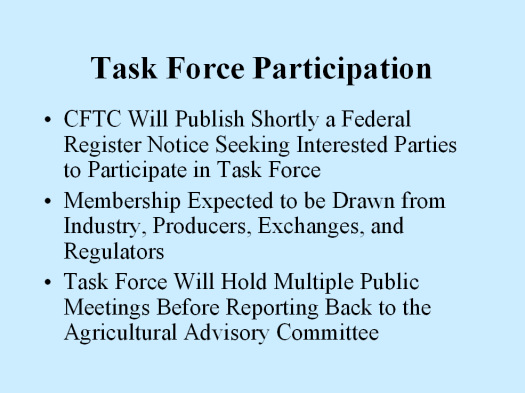
As I said earlier, I am hopeful that the Commission will soon issue a concept release seeking public comments on how the Commission should consider revising the way it classifies commercial and speculative traders and how it issues exemptions to speculative position limits for hedgers. Similarly Congress is examining whether to require federal position limits for essentially all physical commodities.
These are good steps, and I encourage all of you to share your thoughts, concerns and suggestions with the Commission and with Congress on these matters.
5. Adequate CFTC funding.
The CFTC continues to face significant resource challenges. Without additional resources, the CFTC will not be able to fulfill its regulatory charge.
With the likelihood of increased agency authorities and responsibilities, combined with a restrictive budget, it is imperative that the CFTC obtain increased funding immediately to avoid serious impairment of the CFTC’s ability to protect the markets, and customers who use them, from fraud and abuse.
I fully intend to continue the CFTC’s efforts to ensure that its budget is commensurate with its increased regulatory challenges.
Last Updated: June 10, 2010

